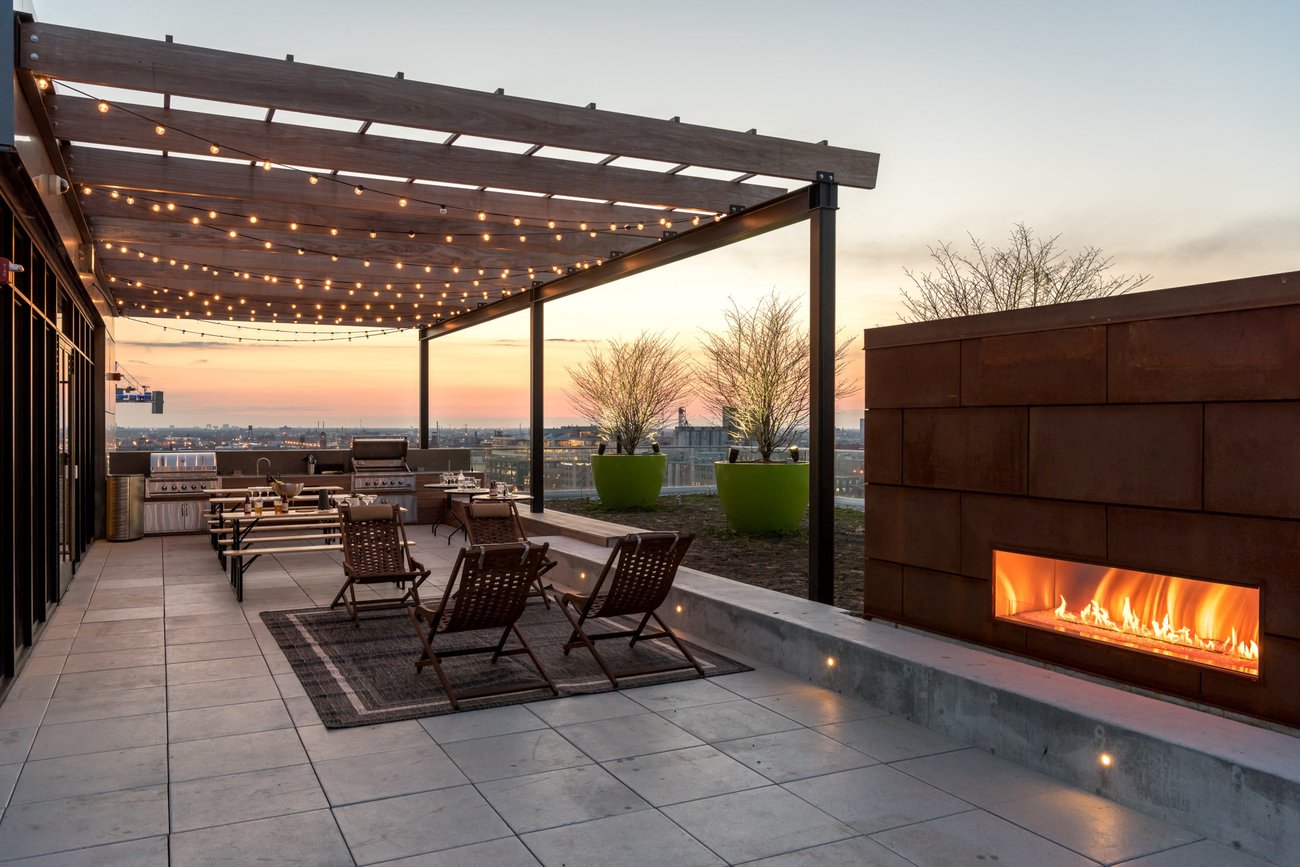
Top image: QUARTERS in Chicago.
Co-living is a living arrangement inspired by millennials who share similar values, and this shared living is disrupting the property market worldwide.
It’s like upscale dorm living, and millennials are attracted to it around the world. Tenants have their own private rooms but share communal spaces. From New Zealand to North America to Europe and almost everywhere in between, post-university working professionals who don’t want to go through the apartment paperwork hassle, or who are on a working holiday, or who are trying to figure out what’s next in life, are able to live in upscale neighborhoods, and in nice buildings or houses. Co-living is attractive because it offers flexibility and time with an easy move-in process.

QUARTERS in New York City.
This concept of shared living is growing in New Zealand, Germany, and the US. Two companies, Co-Live Queenstown in New Zealand and The Medici Living Group based in Berlin, are making inroads in the shared living space. And who better than the Kiwis and the Germans to disrupt the property market? According to the Ministry of Foreign Affairs, Germany is New Zealand’s sixth largest trading partner. Nearly 15,000 young Germans are granted working holiday visas to New Zealand, and nearly 80,000 German tourists visit New Zealand each year.
Co-Live Queenstown was started by Mary Jaynes and Rory Sullivan, who met in a co-living situation themselves. From that, the duo birthed Co-Live Queenstown with the hope that they would create ‘seamless living’ for others in New Zealand.
It’s working quite well in Aotearoa. According to Mary, “The seamless nature of co-living is also attracting New Zealanders too. It’s attractive for Kiwis who still want to live in a shared living environment, but no longer want the hassles of traditional flatting.”

Co-Live Queenstown.
Europe has been at the helm of this different kind of living. For instance, The Medici Living Group has developed an innovative and digitalised living concept, and they are moving with the culture and the needs of this millennial generation. Launched in 2012 by CEO and founder Gunther Schmidt – together with co-founders and managing directors Robert Gmeiner and Ferdinand von Fumetti – the company has now broken into the US market as well.
They have two brands: Medici Living, a professional flat sharing brand (which is ideal for students and interns), and QUARTERS, which is a unique way of living with a focus on community for young professionals. In Germany, QUARTERS is located in Berlin, and in the US, there are two properties in New York City and Chicago. The goal is to open QUARTERS in all major US and European cities in the next 12 to 24 months.
For Schmidt, the concept is simple. “Just bring your suitcase. Everything else is taken care of.”

QUARTERS in New York City.
When asked why the concept of co-living has taken off and why his company is successful in Germany and the US, Schmidt points out that the real estate industry hasn’t really changed in the last 50 years, but consumer behaviour has.
Schmidt also points out that real estate players, especially in the US, have been watching the successes of office co-working, and they want to be at the forefront of co-living. “We are the biggest co-living player in the market with over 1,450 members. We’re in three countries, and we’re backed by leading real estate investors from Europe and the US. We’re a good match for the real estate industry that needs to make sure they are dealing with professional partners, that have the right financial and operational setup.”

QUARTERS in New York City.
The benefits of co-living
The social life
You meet people from all over the world in your co-living space. Cities, though they are full of people, can be full of lonely people. In February 2018, the British government appointed a minister for loneliness. We all know that cities have high turnover rates with people coming and going every 2-3 years. Berlin has had large numbers of expats moving there in recent years, but it has been listed as one of the loneliest cities by Be News Berlin. QUARTERS services have been able to provide living spaces that take the edge off of the loneliness. According to Schmidt, “there are many beautiful stories to be told and I am very fortunate to see them happen every day as I also live in one of our buildings.”

Medici Living Group CEO and founder Gunther Schmidt.
Looking at one example of the benefits of co-living, Schmidt shares the story of “Brad,” a freelance UX designer who moved to Berlin from Australia without knowing anybody. “By joining all of our weekly events that we host in our community space he got in touch with a lot of like-minded people and connected immediately. This enabled him to have a much better start in Berlin. And now, thanks to the community, he even found 2 co-founders for his new blockchain startup.”
Mary Jaynes at Co-Live Queenstown is seeing the benefits of their tenants’ social life. “We are finding many travellers coming to Queenstown for 6-12 months on their working holiday. They are looking for somewhere they can find a sense of community and connection. We often have tenants come to us after being in town for a few months, struggling to find friends. They hear about our concept and are happy to wait a few weeks to a month just to live in one of our houses. We often hear tenants talking about their flatmates as their family.”

Co-Live Queenstown.
Upscale furnishings
Fact: furniture can be expensive. So, if a place already is modern with new furniture and appliances, it can be a real bonus.
Co-Live Queenstown provides a private bedroom, all properties are fully furnished, cleaning services are inclusive, utilities are included, basic supplies like toilet paper and cleaning products are in the house, internet is provided, and laundry facilities are included. They also offer something unique with digital platforms. The company set up social media groups for each house so that the communities are easily able to connect with one another.

QUARTERS in Chicago.
The environment of the homes is key to their success, which includes quality furnishings. “It is amazing how effective good art work is in changing the vibe of a home,” says Mary.
Over at Medici Living and QUARTERS, the design levels vary, as the companies are targeting two different audiences. QUARTERS provides furniture that is designed by their internal design team, the mattresses are provided by Casper, and there’s new linen, closets and a working table in each room. All QUARTERS members have access to smart home apps to control features by their phone. For example, the room temperature, blinds, lights, and the door lock for the room and building are controlled by apps.
_large.jpg)
QUARTERS in New York City.
Monthly living costs are not as much as renting a private apartment
For Co-Live Queenstown, “tenants love the idea of an all-inclusive package where they don’t have to worry about all the finer details of flatting,” says Mary. “Our model of ‘seamless living’ allows people to live better together. It eliminates all those little arguments and tensions that can arise when people don’t pull their weight with cleaning and paying bills on time.”
For QUARTERS, “we want to be the most affordable standardized product in the market. Our pricing is usually 15-20 percent below studio cost,” says Schmidt.
In Chicago, QUARTERS apartments can accommodate between two and five people, with bedroom square footage ranging from 77 to 198 square feet (7 to 18 square meters). Rents begin at $999 (NZ$1,432) per month and average about $1,600 (NZ$2,293) per month, including utilities, Wi-Fi, communal kitchens, bathrooms, laundry, weekly events and much more.
The QUARTERS property that’s located in Chicago’s Fulton neighbourhood includes an outdoor grill, fireplaces, a rooftop terrace with a skyline bar, and cabana loungers. The QUARTERS NYC Lower East Side property, owned by Empire Capital Holdings, has monthly rent that averages around $1,800 (NZ$2,580). For QUARTERS East Village, rent starts from $1,750 (NZ$2,508) with short-term rents as short at three months.

Co-Live Queenstown.
Coming to a city near you
Co-Live Queenstown is planning to expand outside of Queenstown to other parts of New Zealand. “We are currently talking to investors and developers in Auckland and Wellington, with Dunedin and Christchurch in our sights too,” says Mary. “We are currently one month away from starting our second co-live home. It has taken eight months to design. All bedrooms will have ensuites, with multiple living areas.”

QUARTERS in New York City.
For QUARTERS, they plan to expand within the next 24 months, where there will be a QUARTERS building in every major European and US city. Says Schmidt: “At the same time, we are adding additional locations in different neighbourhoods in our existing markets – take, for example, New York. We started in the Lower East Side, now we have taken another location in the East Village of the city and have signed a few more additional locations in other NY districts. We are also very interested to look at markets like New Zealand, and are open to local real estate partners that want to bring QUARTERS into their city.”

QUARTERS in Chicago.
Originally from the American South, Ally Portee has lived in the US, Spain, England, and Germany- all places that have influenced her writing. She’s a communications professional with experience in Fintech, Marketing and PR. Her work has appeared in Propel Women and Converge Magazine. She can be found on Twitter @allyportee.




